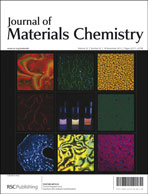Tuning the selectivity and sensitivity of mesoporous dielectric multilayers by modifiying the hydrophobic–hydrophilic balance of the silica layer†
Abstract
We investigate the possibility of tuning the selectivity and sensitivity of SiO2/TiO2 mesoporous dielectric multilayers for the adsorption of analytes with different chemical polarities. The hydrophilic–hydrophobic balance of the mesoporous SiO2 layer was controlled by one-pot co-condensation of mixtures of


 Please wait while we load your content...
Please wait while we load your content...